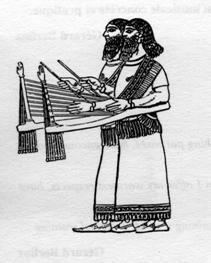Classification Struck | ||
 | ||
The santur (also santour, santoor ) (Arabic: سنطور) is a hammered dulcimer of Mesopotamian origin. It is a trapezoid box zither with a walnut body and ninety two steel (or bronze) strings. The strings, tuned to the same pitch in groups of four, are struck with two wooden mallets called "midhrab". The tuning of these twenty-three sets of strings extends from the lower yakah (G) up to jawab jawab husayni (a). The bridges are called dama (chessmen in Iraqi Arabic) because they look like pawns. The name 'santur' is thought to be derived from the Greek psalterion which, itself, is the result of musical experiments by Phythagorus based on the 6,000-year-old bull-headed lyre discovered from excavations found in the ancient city of Ur ('Children's Book of Music' ISBN 978-0-7566-6734-4). It is also thought that the name is derived from "Sant"- "Ur", meaning sound of Ur in Sumerian. It is native to Iraq, India, Pakistan, Turkey, Iran and Azerbaijan.
It is the main instrument used in the classical Maqam al-iraqi tradition along with the Iraqi spike fiddle joza. ('Music of the Arabs' ISBN 0-931340-88-8). The instrument was brought to Europe by the Arabs through North Africa and Spain during the Middle Ages and also to China where it was referred to as the "foreign qin".
The Iraqi santur has, since its inception, been fully chromatic allowing for full maqam modulations. It uses 12 bridges of steel strings on both sides, and has three movable bridges: B half flat qaraar, E half flat and B half flat jawaab. The non-standard version of the Iraqi santur includes extra bridges so that there's no need to move those three bridges. However, playing it is a bit harder than playing the standard 12-bridge santur. ('Music of the Arabs' ISBN 0-931340-88-8) For a video demonstration, see Wesam al-Azzawy's video links in the sections below.
History
The santur was invented in Mesopotamia (modern-day Iraq, Kuwait, and parts of Iran, Syria and Turkey). This instrument was traded and traveled to different parts of the middle east and each country customized and designed their own versions to adapt to their musical scales and tunings. The original santur was made with tree bark, stones and stringed with goat intestines. The Mesopotamian santur is also the father of the harp, the Chinese yangqin, the harpsichord, the qanun, the cimbalom and the American and European hammered dulcimers. ('Music of the Arabs' ISBN 0-931340-88-8) .
